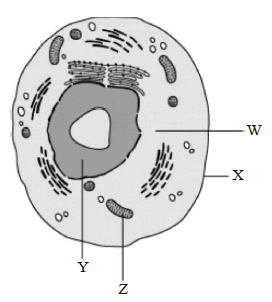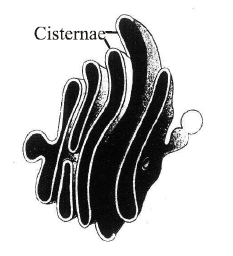
Which function is carried out by the cell organelle 'X'?
helps control the movement of substance in and out of the cell
passes information from the parent cell to newly formed cell
maintains the proper shape of the cell and serves as a protective barrier
helps the cell to make food with the help of chlorophyll and sunlight
Correct Answer :
A. helps control the movement of substance in and out of the cell
The cell membrane (marked as x) helps control entry and exit of substances into the cell. Nucleus passes the information from the parent cell to the new cell. It is also called the control center of the cell. A cell wall is the tough, rigid layer present outside of the plant cell. It provides structural support and protection to the cell. Chloroplast occurs in the plant cells and contains chlorophyll that helps the cell in making food.
Related Questions
Polysome is a chain of
oxysomes
sphaerosomes
ribosomes
dictyosomes
According to widely accepted fluid mosaic model cell membranes are semi-fluid, where lipids and integral proteins can diffuse randomly. In recent years, this model has been modified in several respects. In this regard, which of the following statements is incorrect?
Proteins in cell membranes can travel within the lipid bilayer.
Proteins can also undergo flip-flop movements in the lipid bilayer.
Proteins can remain confined within certain domains of the membrane.
Many proteins remain completely embedded within the lipid bilayer.
Which of the following will determines the shape of the cells and provides a strong structural support to prevent the bacterium from bursting or collapsing?
Plasmids
Cell wall
Mesosome
Cell membrane
Which one of the following pairs is not correctly matched?
Cristae The tubular structure formed by the folding of the inner membrane of the mitochondrion.
Plasmodesmata The membrane surrounding the vacuole in plants.
Grana Membrane bound discs in chloroplasts that contain chlorophylls and carotenoids.
Middle lamella Layer between adjacent cells walls in plants derived from cell plate.
Choose the wrong statements regarding bacterial cell
- Glycocalyx is the outermost envelope in bacteria.
- The glycocalyx could be a loose sheath called capsule.
- The glycocalyx may be thick and tough called slime layer.
- A special structure formed by the plasma membrane is called mesosome.
- Small bristle like fibres sprouting out of the cell are called fimbriae.
(i) and (iii)
(i) and (ii)
(ii) and (iii)
(i) and (iv)
Which of the following statements are correct?
Na+/K+ pump is an example of active transport.
In plant cells lipid like steroidal hormones are synthesized in SER.
In plant cells, the vacuoles can occupy up to 10% of the volume of the cell.
Chlorophyll and leucoplast are responsible for trapping light energy essential for photosynthesis.
Which of the following statement of a bacterial cell is/are correct?
- Mesosome is formed by the extensions of plasma membrane into the cell.
- The pili are elongated tubular structures made up of a protein.
- Flagellum is composed of filament, hook and basal body.
- Ribosomes are about 30 nm by 50 nm in size.
(i), (ii), (iii)
All of the above
(ii) & (iv)
None of the above
Identify the cell organelle given below. Which is an important site of formation of glyeoproteins & glycolipids

Rough endoplasmic reticulum
Smooth endoplasmic reticulum
Golgi body
mitochondria
Who proposed the theory that Cells arise only from the pre-existing cells?
Mohl
Virchow
Haeckel
Brown
Match column I (cell type) with column II (size) and choose the correct option.
| Column-I | Column-II |
|---|---|
| (Cell type) | (Size) |
| A. Viruses | I. 1-2 ??m |
| B. PPLO | II. 10-20 ??m |
| C. Eukaryotic cell | III. About 0.1 ??m |
| D. Bacterium | IV. 0.02 - 0.2 ??m |
A I, B II, C III, D IV
A IV, B III, C II, D I
A I, B III, C II, D IV
A IV, B II, C III, D I
The figure below shows the structure of a mitochondrion with its four parts labelled (A), (B), (C) and (D).

Select the part correctly matched with its function.
Part (D): Outer membrane Gives rise to inner membrane by splitting.
Part (B): Inner membrane Forms infoldings called cristae.
Part (C): Cristae Possess single circular DNA molecule and ribosomes.
Part (A): Matrix Major site for respiratory chain enzymes.
What would happen if lysosomes get ruptured in a cell?
Cell dies
Cell shrinks
Cell swell up
Nothing would happen
Which of the following is incorrect ?
Mycoplasma is the smallest cell (0.3 �).
Bacteria are 3 to 5 �m in size.
The largest cell is the egg of an ostrich.
Nerve cells are some of the smallest cells.
In which method of transport, plasma membrane does not require carrier molecule?
Active transport
Facilitated diffusion
Simple diffusion
Na+ K+ pump
In which of the following the cells are held together by a Ca-pectate layer?
Primary cell wall
Secondary cell wall
Middle lamella
Tertiary cell wall
The given diagram shows the types of chromosomes (labelled as A, B, C & D) based on the position of centromere.
Which one is the correct option for the labelled chromosomes. A, B, C and D ?

A Telocentric chromosome, B Acrocentric chromosome, C Submetacentric chromosome, D Metacentric chromosome
A Acrocentric chromosome, B Telocentric chromosome, C Metacentric chromosome, D Submetacentric chromosome
A Submetacentric chromosome, B Metacentric chromosome, C Telocentric chromosome, D Acrocentric chromosome
A Metacentric chromosome, B Submetacentric chromosome, C Acrocentric chromosome, D Telocentric chromosome.
pH of vacuolar cell sap is
neutral and isotonic.
alkaline and isotonic.
acidic and hypertonic.
equal to cytoplasm and isotonic.
Which of the following organelles is directly connected to the outer membrane of the nucleus in a eukaryotic cell?
Mitochondrion
Lysosome
Golgi apparatus
Endoplasmic reticulum
Which of the following is absent in prokaryotes?
DNA
RNA
Plasma membrane
Mitochondria
Satellite means
terminal part of the chromosome beyond secondary constriction.
terminal part of the chromosome beyond primary constriction.
terminal part of chromosome beyond tertiary constriction.
none of the above
The given diagram shows the sectional view of a mitochondrion.

Identify the parts labelled as A, B, C, D & E
A - Outer membrane, B - Inner membrane, C - Matrix, D - Inter- membrane space, E - Crista
A - Outer membrane, B - Inner membrane, C - Intermembrane space, D - Matrix, E - Crista
A - Outer membrane, B - Inner membrane, C - Matrix, D - Crista, E - Inter - membrane space
A - Outer membrane, B - Inner membrane, C- Crista, D - Matrix, E - Inter-membrane space
In prokaryotes, chromatophores are
specialized granules responsible for colouration of cells
structures responsible for organizing the shape of the organism.
inclusion bodies lying free inside the cells for carrying out various metabolic activities.
internal membrane system which becomes extensive and complex in photosynthetic bacteria.
Match column-I with column-II and choose the correct option.
| Column-I | Column-II |
|---|---|
| (Chromosome) | (Position of Centromere) |
| A. Metacentric | I. At the tip |
| B. Submetacentric | II. Almost near the tip |
| C. Acrocentric | III. At the middle |
| D. Telocentric | IV. Slightly away from the middle |
A III; B IV; C II; D I
A IV; B III; C II; D I
A I; B II; C III; D IV
A IV; B III; C I ; D II
Match column-I with column-II and select the correct option.
| Column - I | Column - II |
|---|---|
| A. Golgi apparatus | I. Storage |
| B. Mitochondria | II. Photosynthesis |
| C. Vacuoles | III. Transport |
| D. Grana | IV. Secretion |
| .. | V. Respiration |
A - IV, B - V, C - I, D - II
A - I, B - II, C - IV, D - III
A - IV, B - I, C - II, D - III
A - I, B - II, C - III, D - IV
Which of the following statements is/are correct ?
- The shape of the cells may vary with the function they perform.
- Human RBC is about 7.0 ??m in diameter.
- Cytoplasm is the main area of cellular activities.
- Various chemical reactions occur in cytoplasm to keep the cell in the living state.
(i), (ii), (iii) and (iv)
Only (i) and (ii)
Only (iv)
None of the above
Match column-I (scientists) with column-II (discovery) and select the correct option.
| Column-I | Column-II |
|---|---|
| A. Leeuwenhoek | I. First saw and described a living cell |
| B. Robert Brown | II. Presence of cell wall is unique to plant cells |
| C. Schleiden | III. Discovered the nucleus |
| D. Schwann | IV. All plants are composed of different kind of cells |
A I, B III, C IV, D II
A I, B III, C II, D IV
A III, B I, C IV, D II
A I, B IV, C II, D III
Which of the following statements is/are correct ?
- The endomembrane system includes plasma membrane, ER, Golgi complex, lysosomes and vacuoles.
- ER helps in the transport of substances, synthesis of proteins, lipoproteins and glycogen.
- Ribosomes are involved in protein synthesis.
- Mitochondria help in oxidative phosphorylation and generation of ATP.
(ii), (iii) & (iv)
(i) only
(ii) only
(iii) only
Both the membranes of mitochondrion are
structurally different but functionally similar.
structurally as well as functionally different.
structurally similar but functionally different.
structurally different but functionally similar.
_______________ is the important site of formation of glycoproteins and golycolipids.
SER
Lysosome
Golgi apparatus
Mitochondria
Match column-I and column-II and select the correct answer
| Column-I | Column-II |
|---|---|
| A. Bacteria without walls | I. Lysosome |
| B. Small circular DNA | II. Mycoplasma cells |
| C. Flattened sacs in | III. Thylakoid a chloroplast |
| D. A vesicle in which | IV. Plasmid hydrolytic enzymes are stored |
A III; B IV; C II; D I
A II; B IV; C III; D I
A I; B II; C III; D IV
A IV; B III; C I ; D II
